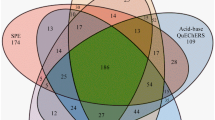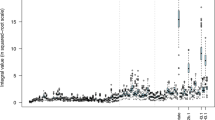Abstract
The rumen is a unique organ that serves as the primary site for microbial fermentation of ingested plant material for domestic livestock such as cattle, sheep and goats. The chemical composition of ruminal fluid is thought to closely reflect the healthy/unhealthy interaction between rumen microflora and diet. Just as diet and feed quality is important for livestock production, rumen health is also critical to the growth and production of high quality milk and meat. Therefore a detailed understanding of the chemical composition of ruminal fluid and the influence of diet on its composition could help improve the efficiency and effectiveness of farming and veterinary practices. Consequently we have undertaken an effort to comprehensively characterize the bovine ruminal fluid metabolome. In doing so, we combined NMR spectroscopy, inductively coupled plasma mass-spectroscopy (ICP-MS), gas chromatography-mass spectrometry (GC-MS), direct flow injection (DFI) mass spectrometry and lipidomics with computer-aided literature mining to identify and quantify essentially all of the metabolites in bovine ruminal fluid that can be routinely detected (with today’s technology). The use of multiple metabolomics platforms and technologies allowed us to substantially enhance the level of metabolome coverage while critically assessing the relative strengths and weaknesses of these techniques. Tables containing the set of 246 ruminal fluid metabolites or metabolite species, their concentrations, related literature reference and links to their known diet associations for the bovine rumen metabolome are freely available at http://www.rumendb.ca.




Similar content being viewed by others
References
AbuGhazaleh, A. A., Schingoethe, D. J., Hippen, A. R., & Whitlock, L. A. (2002). Feeding fish meal and extruded soybeans enhances the conjugated linoleic acid (CLA) content of milk. Journal of Dairy Science, 85, 624–631.
Ametaj, B. N., Zebeli, Q., & Iqbal, S. (2010a). Nutrition, microbiota, and endotoxin-related diseases in dairy cows. Revista Brasileira de Zootecnia, 39, 433–444.
Ametaj, B. N., Zebeli, Q., Saleem, F., Lewis, M. J., Psychogios, N., Xia, J., et al. (2010b). Metabolomics reveals unhealthy alterations in rumen metabolism with increased proportion of cereal grain in the diet of dairy cows. Metabolomics, 6, 583–594.
Attaelmannan, M. A., Dahl, A. A., & Reid, R. S. (1999). Analysis of volatile fatty acids in rumen fluid by proton NMR spectroscopy. Canadian Journal of Animal Science, 79, 401–404.
Bailey, C. B., & Balch, C. C. (1961). Saliva secretion and its relation to feeding in cattle. British Journal of Nutrition, 15, 383–402.
Bertram, H. C., Kristensen, N. B., Malmendal, A., Nielsen, N. C., Brod, R., Andersen, H. J., et al. (2005). A metabolomic investigation of splanchnic metabolism using 1H NMR spectroscopy of bovine blood plasma. Analytica Chimica Acta, 536, 1–6.
Bertram, H. C., Kristensen, N. B., Vestergaard, M., Jensen, S. K., Sehested, J., Nielsen, N. C., et al. (2009). Metabolic characterization of rumen epithelial tissue from dairy calves fed different starter diets using 1H-NMR spectroscopy. Livestock Science, 120, 127–134.
Bligh, E. G., & Dyer, W. J. (1959). A rapid method of total lipid extraction and purification. Canadian Journal of Biochemistry and Physiology, 37, 911–917.
Bruford, M. W., Bradley, D. G., & Luikart, G. (2003). DNA markers reveal the complexity of livestock domestication. Nature Reviews Genetics, 4, 900–910.
Buscher, J. M., Czernik, D., Ewald, J. C., Sauer, U., & Zamboni, N. (2009). Cross-platform comparison of methods for quantitative metabolomics of primary metabolism. Analytical Chemistry, 81, 2135–2143.
Canadian Council on Animal Care. (1993). Guide to the care and use of experimental animals (2nd ed., Vol. 1). Ottawa: CCAC.
Cava-Montesinos, P., Cervera, M. L., Pastor, A., & de la Guardia, M. (2005). Room temperature acid sonication ICP-MS multielemental analysisof milk. Analytica Chimica Acta, 531, 111–123.
Cheng, D., Knox, C., Young, N., Stothard, P., Damaraju, S., & Wishart, D. S. (2008). PolySearch: A web-based text mining system for extracting relationships between human diseases, genes, mutations, drugs and metabolites. Nucleic Acids Research, 36, W399–W405.
Christie, W. W. (2003). Lipid analysis: Isolation, separation, identification and comparison of methods for quantitative metabolomics of primary metabolism. Analytical Chemistry, 81, 2135–2143.
Craig, J. V. (1981). Domestic animals behaviour: Causes and implication for animal care and management (pp. 21–31). Englewood Cliffs, NJ: Prentice Hall.
Drackley, J. K., & Dann, H. M. (2005). New concepts in nutritional management of dry cows. Advances in Dairy Technology, 17, 11–23.
Emmanuel, D. G. V., Dunn, S. M., & Ametaj, B. N. (2008). Feeding high proportions of barley grain stimulates an inflammatory response in dairy cows. Journal of Dairy Sciences, 91, 606–614.
Ferber, K. E., & Winogradowa-Fedorowa, T. (1929). Zahlung und Teilungs quote der Infusorien im Pansen. Biologisches Zentralblatt, 49, 321–328.
Fiehn, O., Wohlgemuth, G., & Scholz, M. (2005). Setup and annotation of metabolomic experiments by integrating biological and mass spectrometric metadata. Lecture Notes in Computer Science, 3615, 224–239.
Forano, E., Delort, A. M., & Matulova, M. (2008). Carbohydrate metabolism in Fibrobacter succinogenes: What NMR tells us. Microbial Ecology in Health and Disease, 2, 94–102.
Giuffra, E. J., Kijas, J. M. H., Amarger, V., Carlborg, Ö., Jeon, J. T., & Andersson, L. (2000). The origin of the domestic pig: Independent domestication and subsequent introgression. Genetics, 154, 1785–1791.
Hackmann, T. J., & Spain, J. N. (2010). Ruminant ecology and evolution: Perspectives useful to livestock research and production. Journal of Dairy Science, 93, 1320–1334.
Hamilton, J. G., & Comai, K. (1984). Separation of neutral lipids and free fatty acids by high-performance liquid chromatography using low wavelength ultraviolet detection. The Journal of Lipid Research, 25, 1142–1148.
Harfoot, C. G., Noble, R. C., & Moore, J. H. (1973). Factors influencing the extent of biohydrogenation of linoleic acid by rumen microorganisms in vitro. Journal of the Science of Food and Agriculture, 24, 961–970.
Hess, M., Sczyrba, A., Egan, R., Kim, T. W., Chokhawala, H., Schroth, G., et al. (2011). Metagenomic discovery of biomass-degrading genes and genomes from cow rumen. Science, 331, 463–467.
Ingvartsen, K. L. (2006). Feeding- and management-related diseases in the transition cow: Physiological adaptations around calving and strategies to reduce feeding-related diseases. Animal Feed Science and Technology, 126, 175–213.
Ivanova, P. T., Milne, S. B., Myers, D. S., & Brown, H. A. (2009). Lipidomics: A mass spectrometry based systems level analysis of cellular lipids. Current Opinion in Chemical Biology, 13, 526–531.
Jiye, A., Trygg, J., Gullberg, J., Johansson, A. I., Jonsson, P., Antti, H., et al. (2005). Extraction and GC/MS analysis of the human blood plasma metabolome. Journal of Analytical Chemistry, 77, 8086–8094.
Jurgens, M. H. (1978). Animal feeding and nutrition (5th ed.). Dubuque, IA: Kendall/Hunt Publishing Company.
Kegley, E. B., Harvey, R. W., Spears, J. W., & Crickenberge, R. G. (1990). The effects of lysocellin and varying calcium levels on performance and ruminal and plasma characteristics of growing beef steers fed corn silage. Journal of Animal Science, 68, 483–489.
Lewis, T. R., & Emeryr, R. S. (1962). Intermediate products in the catabolism of amino acids by rumen micro-organisms. Journal of Dairy Science, 45, 1363–1368.
Lock, A. L., Harvatine, K. J., Ipharraguerre, I., Amburgh, M., Drackley, J. K., & Bauman, D. E. (2006). Dynamics of ruminant fat digestion: Part 1. Fatty acid metabolism of ruminants. Feedstuffs, 78, 16–17.
McAllister, T. (2000). Learning more about rumen bugs: Genetic and environmental factors affecting rumen bugs. Southern Alberta Beef Review, 2:1.
Nocek, J. E. (1997). Bovine acidosis: Implications on laminitis. Journal Dairy Science, 80, 1005–1028.
NRC. (2001). Nutrient requirements of dairy cattle (7th rev. ed.). Washington, DC: National Academy of Sciences.
Owens, F. N., Secrist, D. S., Hill, W. J., & Gill, D. R. (1998). Acidosis in cattle: A review. Journal of Animal Science, 76, 275–286.
Psychogios, N., Hau, D. D., Peng, J., Guo, A. C., Mandal, R., et al. (2011). The human serum metabolome. PLoS ONE, 6, e16957.
Saude, E. J., Slupsky, C. M., & Sykes, B. D. (2006). Optimization of NMR analysis of biological fluids for quantitative accuracy. Metabolomics, 2, 113–123.
Weljie, A. M., Newton, J., Mercier, P., Carlson, E., & Slupsky, C. M. (2006). Targeted profiling: Quantitative analysis of H-1 NMR metabolomics data. Analytical Chemistry, 78, 4430–4442.
Wenk, M. R. (2005). The emerging field of lipidomics. Nature Reviews Drug Discovery, 4, 594–610.
Wishart, D. S. (2008a). Metabolomics: Applications to food science and nutrition research. Trends in Food Science & Technology, 19, 482–493.
Wishart, D. S. (2008b). Quantitative metabolomics using NMR. Trends in Analytical Chemistry, 27, 228–237.
Wishart, D. S., Knox, C., Guo, A. C., Eisner, R., Young, N., et al. (2009). HMDB: A knowledgebase for the human metabolome. Nucleic Acids Research, 37, D603–D610.
Wishart, D. S., Lewis, M. J., Morrissey, J. A., Flegel, M. D., Jeroncic, K., Xiong, Y., et al. (2008). The human cerebrospinal fluid metabolome. Journal of Chromatography, B: Analytical Technologies in the Biomedical and Life Sciences, 871, 164–173.
Zhang, Q., Wysocki, V. H., Scaraffia, P. Y., & Wells, M. A. (2005). Fragmentation pathway for glutamine identification: Loss of 73 Da from dimethylformamidineglutamine isobutyl ester. Journal of the American Society for Mass Spectrometry, 16, 1192–1203.
Acknowledgments
Financial support for this work was provided by the Alberta Agricultural Research Institute (AARI; Edmonton, Alberta, Canada), the Alberta Livestock and Meat Agency Ltd. (ALMA; Edmonton, Alberta, Canada), Genome Alberta (Calgary, Alberta, Canada) and the Natural Sciences and Engineering Research Council of Canada (NSERC; Ottawa, Ontario, Canada). We also are grateful to the technical staff of Dairy Research and Technology Centre at the University of Alberta for their help in caring for and monitoring the cows used in this study.
Author information
Authors and Affiliations
Corresponding author
Rights and permissions
About this article
Cite this article
Saleem, F., Bouatra, S., Guo, A.C. et al. The Bovine Ruminal Fluid Metabolome. Metabolomics 9, 360–378 (2013). https://doi.org/10.1007/s11306-012-0458-9
Received:
Accepted:
Published:
Issue Date:
DOI: https://doi.org/10.1007/s11306-012-0458-9




